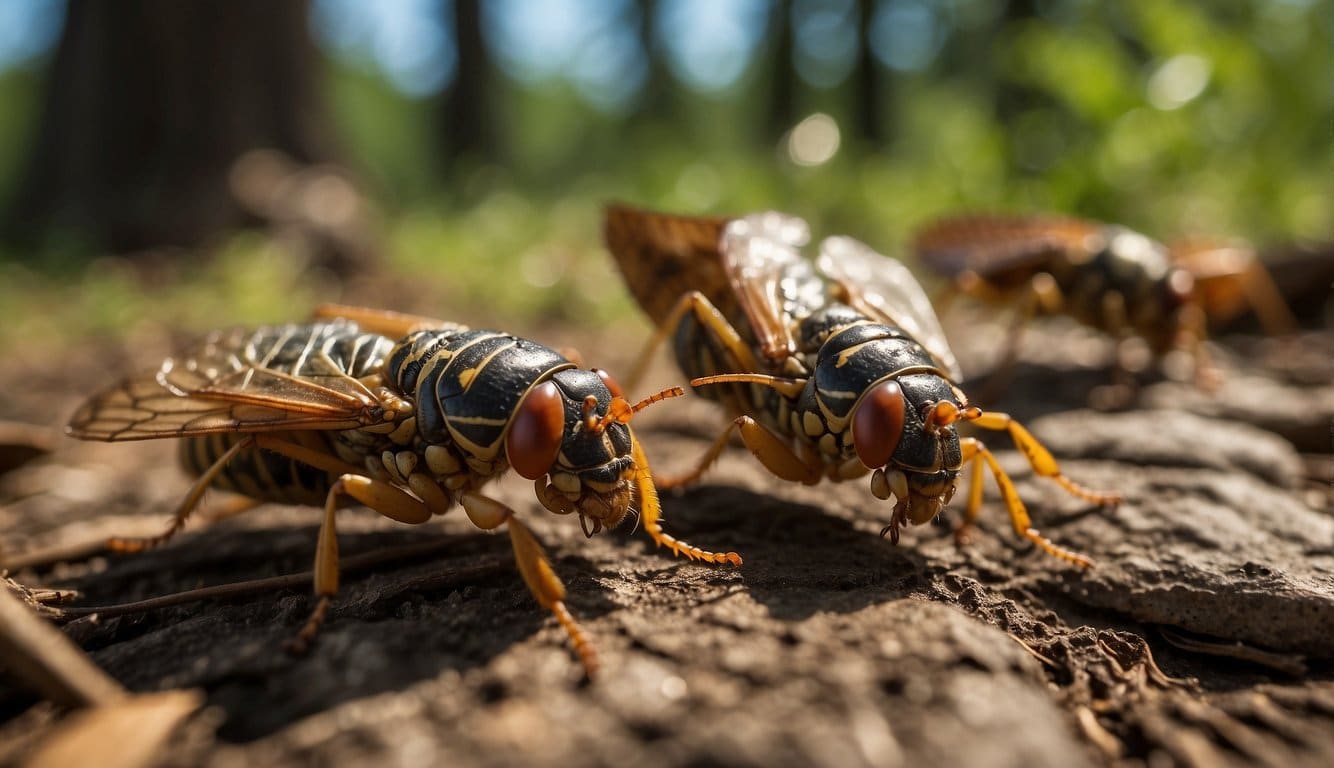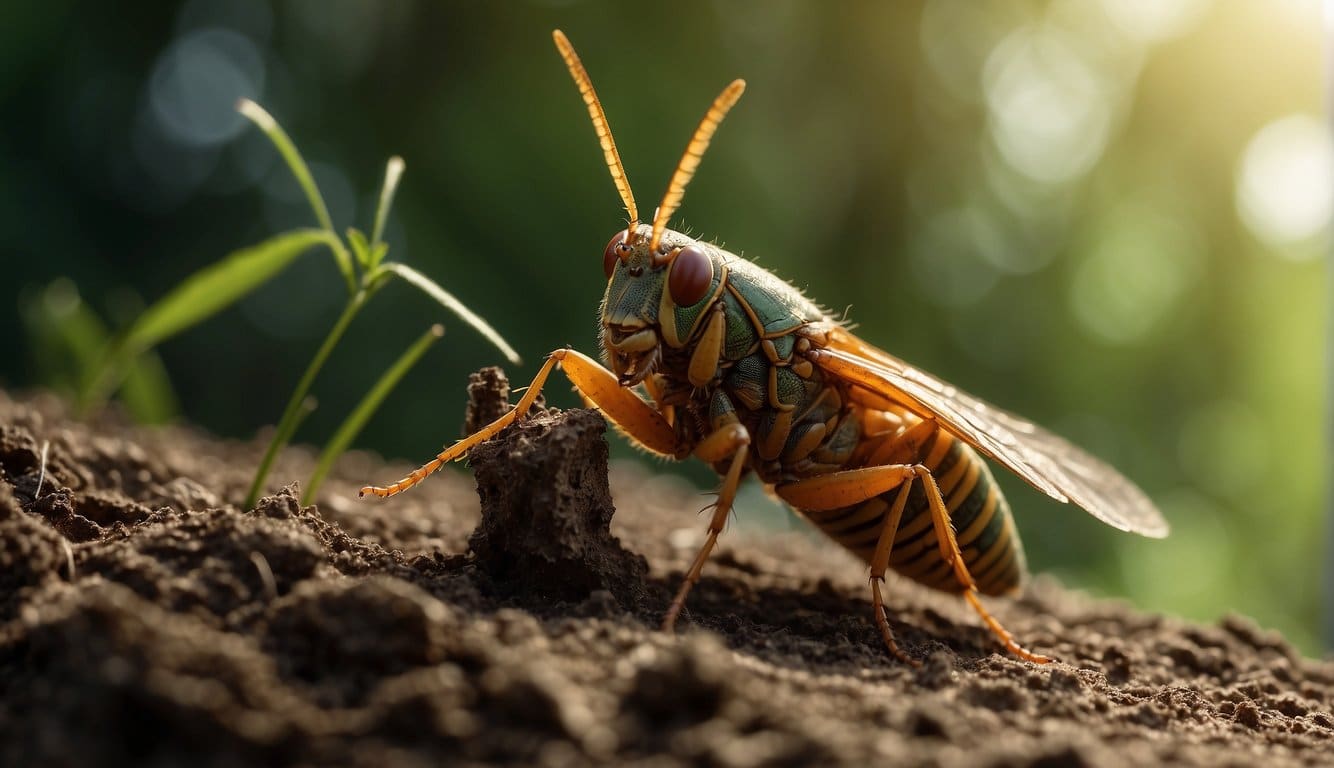Cicada Lifecycle
As you delve into the fascinating world of cicadas, it’s essential for you to grasp the stages they go through while above ground. The cicada lifecycle above the surface is dramatic and short-lived, culminating in a crescendo of fascinating transformations.
Nymph Stage
- Once cicada nymphs are ready to leave their subterranean home, they prepare for one of nature’s most outstanding events.
- At this point in their lifecycle, they are eager to emerge and begin the transition to adulthood.
Emergence
- Picture the scene: the ground cracks open, and literally thousands of nymphs make their appearance simultaneously.
- This coordinated emergence helps saturate the area with cicadas, increasing the chances for survival against predators who feast during this period.
Molting Process
- Soon after surfacing, cicadas undergo a molting process, shedding their nymph exoskeleton.
- Wings develop and harden, and their previously pale bodies gain their characteristic coloration and form.
Duration of the Adult Phase
Once you’ve waited patiently for cicadas to emerge from the ground, the clock starts ticking on their adult lifespan. The adult phase of a cicada is, surprisingly, the shortest part of their lifecycle:
- Periodical Cicadas: These guys have the most synchronized swarming schedules, and once they hit the air, they’re in for a brief yet buzzing bonanza. They typically only grace us with their presence above ground for about three to four weeks. Shortly after this period, they complete their mating rituals and pass on. For more on their short-lived escapades, read about cicadas’ above ground life cycle.
- Annual Cicadas: A bit more flexible with their schedules, their adult phase stretches longer – they can spend two months or more of hot summer days singing in the treetops.
Here’s a quick glance at their time above ground:
| Type of Cicada | Duration Above Ground |
|---|---|
| Periodical | 3 to 4 weeks |
| Annual | Up to 2 months or more |
Remember, this adult phase is all about making the most of their limited time. They’ll sing (well, the males will), mate, and lay the next generation of eggs in the treetops. It’s a life cycle with a poignant reminder: make every moment count! And if you’re keen to track their comings and goings, check out the visual guide to cicadas. Enjoy the natural concert while it lasts, and be prepared to say goodbye to these fascinating insects until their next appearance.
Factors Influencing Lifespan Above Ground
When you witness the mass emergence of cicadas, you might wonder how long these noisy insects get to enjoy their time in the sun. Here’s the buzz on the key factors that determine their above-ground lifespan:
- Predation: Think of cicadas as the all-you-can-eat buffet for wildlife. Birds, small mammals, and even other insects often view these creatures as a tasty meal. Less predation means a longer life for the cicadas lucky enough not to be someone’s lunch!
- Weather Conditions: Cicadas prefer the days sunny and the climate just right. Extreme temperatures, particularly chilly springs or scorching summers, can cut their time short. Mild weather gives them a better shot at a full life cycle.
- Physical Health: Just like you, a cicada’s health can be a coin toss. Those with stronger constitutions have a better chance of surviving the full span, which can be up to several weeks, depending on the species.
Here are a few punchy facts:
- Even though a cicada’s total lifespan can stretch over many years, it’s only a few weeks that they spend serenading you from the treetops.
- For adult cicadas, their time above ground is basically a farewell tour, and it ranges from a mere few weeks up to a month or so.
- During this period, their primary goals are to mate and lay eggs before the curtain falls.
Regional Variations in Lifespan
When you marvel at a buzzing cicada, have you thought about how long these creatures celebrate above ground? Lifespans vary and not just a little bit—there’s a whole symphony of differences depending on where you are.
- Annual Cicadas: Relatively cosmopolitan, these globe-trotters emerge every year and can grace us with their presence for several weeks. Specifically:
- In warmer climates, you might find them sticking around a bit longer. Do the tropics sound good for a few extra days of cicada serenades?
- Transitioning to cooler areas, they tend to have a brisk stay on the surface before bidding adieu until next year.
Now, let’s turn to the periodic performers:
- Periodical Cicadas: These are the stars with seriously rare appearances. You might get mixed up with their schedules—13 or 17 years—depending on the brood.
- The 13-year cicadas often serenade the Upper Midwest.
- Meanwhile, the eastern United States gets the 17-year guest visit.
Upon emergence, both types have one song to sing and it’s a short but memorable one:
- On Stage Life: Even with years of underground prep, once they’re on stage and fully matured:
- Periodical cicadas grace us for a fleeting three to four weeks, maximum, as noted by the experts at the Smithsonian.
- Their annual cousins stick around a little longer, up to two months in some cases.
Frequently Asked Questions
Get ready to explore the short but fascinating journey cicadas undertake once they burst into the daylight from their underground hideaways.
What’s the life span of cicadas once they emerge above ground?
After biding their time under your feet for seventeen long years, cicadas grace the earth’s surface for a fleeting 4 to 6 weeks. During this time, they molt, mate, and lay the next generation before their life cycle concludes.
Can cicadas survive indoors, and if so, for how long?
If a curious cicada finds its way into your home, it can survive for a short period, often no more than a few days. Their lives above ground are tied closely to their natural habitat, so don’t expect a houseguest for long.
During which months are cicadas most active above ground?
These winged singers typically make their grand entrance in late May through early July, depending on the climate and region. They ensure you’ll witness their unique serenade during the warm summer months.
What are cicadas’ habits once they are living above ground?
Once above ground, cicadas are on a mission:
- They shed their exoskeletons to transition into adulthood.
- A symphony ensues as males sing to attract females.
- After mating, females cut small slits in tree branches to lay their eggs.
What transformations do cicadas undergo in their above-ground phase?
The transformation is truly a spectacle as nymphs emerge and promptly shed their skins to unfurl new wings. Now as adults, they are ready to mate and complete their life cycle’s most critical task.
What’s the reason behind cicadas’ lengthy 17-year underground development?
Spending 17 years underground isn’t just for kicks—it’s an evolutionary strategy that helps them avoid predators.
This long-term development leads to their synchronized emergence, creating a survival scenario called predator satiation: simply put, there are too many cicadas for predators to consume them all.

